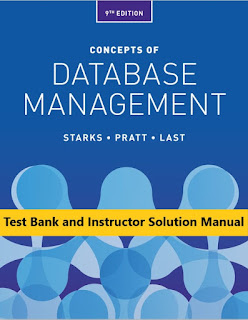Test Bank for Concepts of Database Management 9th Edition Joy L. Starks , Philip J. Pratt , Mary Z. Last
Concepts of Database Management 9th Edition Joy L. Starks , Philip J. Pratt , Mary Z. Last , © 2019 ,ISBN-10: 1337093424
Test Bank and Instructor Solution Manual
its the TEST BANK and Solution Manual
not the TEXTBOOK
To request it .. Please contact us via e-mail
[email protected]
or you can use form contact by this link :
https://buy-testbanky.com/contact-us/
Meet the Authors
What’s New
- THIS EDITION OFFERS THE MOST COMPLETE AND CURRENT COVERAGE AVAILABLE IN A CONCISE PRESENTATION. The new edition is easy for students to read and understand. Revisions in every chapter highlight the latest technologies, practices, and developments from the field.
- NEW “YOUR TURN” EXERCISES ENCOURAGE STUDENTS TO APPLY THE SKILLS THEY’VE LEARNED. These new, practical exercises in each chapter engage the student in thinking critically and analytically about specific, common problems.
- COMPLETELY UPDATED CONTENT INCORPORATES SQL SERVER 2016, MICROSOFT® ACCESS 2016, AND OFFICE 365 STANDARDS. This edition’s new full color presentation offers helpful Microsoft® Office screenshots to further guide learning.
- AUTHORS SKILLFULLY PRESENT COMPREHENSIVE AND CURRENT COVERAGE OF DATABASE DESIGN AND DATABASE MANAGEMENT SYSTEMS. Your students gain the tools and skill sets they need for real-world success.
- INTERESTING, CONTEMPORARY CASES APPEAL TO COLLEGE-AGE STUDENTS. A new continuing case problem appears in each chapter throughout the book. In addition, the authors have added a new case to each chapter’s end-of-chapter set of exercises and cases.
- CRITICAL-THINKING QUESTIONS AND EXERCISES NOW ACCOMPANY EACH CASE. These new questions and exercises that appear in every case challenge students to apply and strengthen their problem-solving and analytical skills. In addition, the authors have updated all exercises to reflect the latest developments in the field.
Table of Contents
1. Introduction to Database Management.
2. The Relational Model 1: Introduction, QBE, and Relational Algebra.
3. The Relational Model 2: SQL.
4. The Relational Model 3: Advanced Topics.
5. Database Design 1: Normalization.
6. Database Design 2: Design Method.
7. DBMS Functions.
8. Database Administration.
9. Database Management Approaches.
Appendix A: Comprehensive Design Example: Marvel College.
Appendix B: SQL Reference.
Appendix C: MySQL.
Appendix D: “How Do I” Reference.
Appendix E: Using Access to Create a Web App.
Appendix F: A Systems Analysis Approach to Information-Level Requirements.
2. The Relational Model 1: Introduction, QBE, and Relational Algebra.
3. The Relational Model 2: SQL.
4. The Relational Model 3: Advanced Topics.
5. Database Design 1: Normalization.
6. Database Design 2: Design Method.
7. DBMS Functions.
8. Database Administration.
9. Database Management Approaches.
Appendix A: Comprehensive Design Example: Marvel College.
Appendix B: SQL Reference.
Appendix C: MySQL.
Appendix D: “How Do I” Reference.
Appendix E: Using Access to Create a Web App.
Appendix F: A Systems Analysis Approach to Information-Level Requirements.
